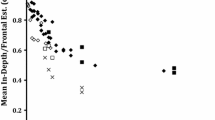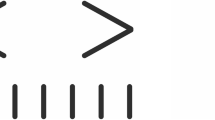Abstract
Psychometric experiments were performed to study the effects of visual field anisotropy and geometrical illusions on the accuracy of comparison of objects in terms of length. Stimuli consisting of V-shaped symbols were used, made up of three light spots or one spot plus components of illusory figures, which were pairs of Müller-Layer wings or an interval of the Oppel-Kundt figure filled with spots of light. Relationships between the length comparison errors and the orientations of the reference and test parts of the stimulus were obtained. The experimental data showed that the simultaneous appearance of illusions and visual field anisotropy can be summed algebraically.
Similar content being viewed by others
REFERENCES
A. I. Bertulis and V. D. Glezer, Spatial Color Vision [in Russian], Nauka, Leningrad (1990).
A. Bulatov. A. Bertulis, and I. Kochanie, “Studies of size discrimination depending on stimulus orientation,” Sensor. Sistemy, 10, No.4, 28–43 (1996).
A. Bulatov, A. Bertulis, and N. Bulatova, “Discrimination of right ankles,” Fiziol. Cheloveka (in press).
A. Bulatov, A. Bertulis, and V. Strogonov, “Distortion of length perception when two images are superimposed,” Fiziol. Cheloveka, 27, No.3, 22–31 (2001).
A. N. Bulatov, A. V. Bertulis, and L. I. Mitskene, “Quantitative studies of geometrical illusions, ” Sensor. Sistemy, 9, No.2–3, 79–93 (1995).
V. D. Glezer, Vision and Thought, Nauka, Leningrad (1985).
D. P. Andrews, “Perception of contour orientation in the central fovea. Part I. Short lines,” Vision Res., 7, 975–997 (1967).
D. P. Andrews, “Perception of contour orientation in the central fovea. Part II. Spatial integration, ” Vision Res., 7, 999–1013 (1967).
S. Appelle, “Perception and discrimination as a function of stimulus orientation. The ‘oblique effect’ in man and animals,” Psychol. Bull., 78, 266 (1972).
A. Bertulis, J. Kocaniene, and A. Bulatov, “Length judgement as a function of stimulus position in the visual field,” Perception, 25, Supplement, 116 (1996).
A. Bertulis and A. Bulatov, “Distortions of length perception in human vision,” Biomedicine (Lithuania), 1, 1 (2001).
G. A. Betts and I. S. Curthoys, “Visually perceived vertical and visually perceived horizontal are not orthogonal,” Vision Res., 38, 1989–1999 (1998).
K. T. Brown, “Factors affecting differences in apparent size between opposite halves of a visual meridian,” J. Opt. Soc. Amer., 43, 464–472 (1953).
H. M. Buchanan-Smith and D. W. Heeley, “Anisotropic axes in orientation perception are not retinotopically mapped,” Perception, 22, 1389–1402 (1993).
A. Bulatov and A. Bertulis, “Distortions of length perception,” Biol. Cybern., 80, 185–193 (1999).
A. Bulatov, A. Bertulis, and J. Kocaniene, “Visual field anisotropy modeling based on nonhomogeneity of cortical magnification factor (nMF),” Perception, 25, Supplement, 84 (1996).
A. Bulatov, A. Bertulis, and L. Mickiene, “Geometrical illusions: study and modeling,” Biol. Cybern., 77, 395–406 (1997).
T. Caelli, “Is perceived length affected by interactions between orientation detectors?” Vision Res., 17, 837–841 (1977).
S. Coren and P. Hoening, “Effect of non-target stimuli upon length of voluntary saccades,” Percept. Mot Skills, 34, 499–508 (1972).
R. H. Day, “Visual spatial illusions. A general explanation,” Science, 175, 1335–1340 (1972).
E. G. H. Eijkman, H. J. Jongsma, and J. Vincent, “Two-dimensional filtering, oriented line detectors, and figural aspects as determinants of visual illusions,” Percept. Psychophys., 29, 352–358 (1981).
L. Festinger, C. W. White, and M. R. Allyn, “Eye movements and decrement in the Müller-Lyer illusion,” Percept. Psychophysiol., 3, 376–382 (1968).
A. A. Gould, “A note on inappropriate constancy-scaling and the Müller-Lyer illusion,” Brit. J. Psychol., 66, 307–309 (1975).
B. Gillam, “Geometrical illusions,” Sci. Amer., 242, 102–111 (1980).
A. P. Ginsburg, “Spatial filtering and visual form perception,” in: Handbook of Perception and Human Performance, K. R. Boff, L. Koufman, and J. P. Thomas (eds.), Wiley, New York (1986), pp. 1–41.
A. P. Ginsburg, “Visual form perception based on biological filtering,“ in: Sensory Experience, Adaptation and Perception,L. Spilman and G. R. Wooten (eds.), Erlbaum, Hillsdale, New York (1984), pp. 53–72.
R. L. Gregory, The Intelligent Eye, Weidenfeld and Nicolson, London (1970).
R. L. Gregory, “Illusory contours. Physiological or cognitive?” Nature, 238, 51–52 (1972).
R. L. Gregory, “Visual illusions,” Sci. Amer., 219, 66–67 (1968).
D. W. Heeley and B. Timney, “Meridional anisotropies of orientation discrimination for sine wave gratings,” Vision Res., 28, 337–344 (1988).
D. W. Heeley and H. M. Buchanan-Smith, “Mechanisms specialized for the perception of image geometry, ” Vision Res., 36, 3607–3627 (1996).
H. Helson, Adaptation-Level Theory, Harper & Row, New York (1964).
L. Kaufman and W. Richards, “Spontaneous fixation tendencies for visual forms,” Percept. Psychophys., 5, 85–88 (1969).
N. Kawabata, “Mathematical analysis of the visual illusion,” IEEE Transactions on Systems, Man, and Cybernetics, 6, 818–824 (1976).
G. Lester, “Size constancy scaling and the apparent thickness of the shaft in the Müller-Lyer illusion,” J. Gen. Psychol., 97, 307–308 (1977).
R. J. W. Mansfield, “Neural basis of orientation preference in primates,” Science New York, 186, 1133–1135 (1974).
R. J. W. Mansfield and S. F. Bonner, “Orientation anisotropy in monkey visual cortex,” Brain Res., 149, 229–234 (1978).
S. C. McLaughlin, M. J. De Sisto, and M. J. Kelley, “Comment on ‘Eye movement and decrement in the Mü ller-Lyer illusion’,” Percept. Psychophys., 5, 28 (1969).
M. J. Morgan, “Hyperacuity,” in: Spatial Vision, D. Regan (ed.), McGraw-Hill, London (1991), Vol. 10, pp. 87–113.
G. A. Orban and H. Kennedy, “The influence of eccentricity on receptive field types and orientational selectivity in areas 17 and 18 of the cat,” Brain Res., 208, 203–208 (1981).
G. A. Orban, E. Vandenbussche, and R. Vogels, “Human orientation discrimination tested with long stimuli,” Vision Res., 24, 121–128 (1984).
G. A. Orban, E. Vandenbussche, and R. Vogels, “Meridional variations and properties suggesting that acuity and orientation discrimination rely on different neuronal mechanisms,” Physiol. Optics, 4, 89, (1984).
A. W. Pressey and M. Bross, “Assimilation theory and the reversed Müller-Lyer illusion,” Perception, 2, 211–217 (1973).
A. W. ressey, N. Butchard, and L. Scrivner, “Assimilation theory and Ponzo illusion. Quantitative predictions,” Canad. J. Psychol., 2, 486–497 (1971).
A. W. Pressey and V. Di Lillo, “Effects of distance between standard and comparison lines on the Müller-Lyer illusion,” Percept. Psychophysiol., 24, 415–419 (1978).
D. Regan and P. Price, “Periodicity in orientation discrimination and the unconfounding of visual information,” Vision Res., 26, 1299–1302 (1986).
F. Restle, “Assimilation produced by contrast,” in: Cognitive Theory, N. J. Castellan and F. Restle (eds.), Erlbaum, N.J. (1977), p. 3.
F. Restle, “Visual illusions,” in: Adaptation Level Theory, M. H. Appley (ed.), Academic Press, New York (1971).
F. Restle and J. Decker, “Size of the Mü ller-Lyer illusion as a function of its dimensions. Theory and data,” Percept. Psychophysiol., 21, 489–503 (1977).
F. Restle and C. T. Merryman, “An adaptation theory account of a relative-size illusion,” Psychonomic Science, 12, 229–230 (1968).
I. Rock and R. Anson, “Illusory contours as the solution to a problem,” Perception, 8, 665–681 (1979).
R. Gusso and A. Dellantonio, “Influence of phenomenon time on perceived space,” Percept. Mot. Skills, 68, 971–984 (1989).
D. A. Smith, “A descriptive model for perception of optical illusions,” J. Mathemat. Psychol., 17, 64–85 (1978).
K. Suzuki and R. Arashida, “Geometrical haptic illusions revisited: haptic illusions compared with visual illnesses,” Percept. Psychophysiol., 52, 329–335 (1992).
V. Virsu, “Tendencies to eye movement, and misperception of curvature, direction, and length,” Percept Psychophys., 9, 65–72 (1971).
E. H. Walker, “A mathematical theory of optical illusions and figural aftereffects,” Percept. Psychophys., 13, 467–486 (1973).
L. M. Ward, C. Porac, S. Coren, and J. S. Gingus, “The case of misapplied constancy scaling. Depth associations elicited by illusion configurations,” Amer. J. Physiol., 90, 604–620 (1977).
Author information
Authors and Affiliations
Additional information
Translated from Rossiiskii Fiziologicheskii Zhurnal imeni I. M. Sechenova, Vol. 89, No. 10, pp. 1265–1280, October, 2003.
Rights and permissions
About this article
Cite this article
Bertulis, A., Bulatov, A. Distortions in length perception: Visual field anisotropy and geometrical illusions. Neurosci Behav Physiol 35, 423–434 (2005). https://doi.org/10.1007/s11055-005-0043-z
Received:
Issue Date:
DOI: https://doi.org/10.1007/s11055-005-0043-z




